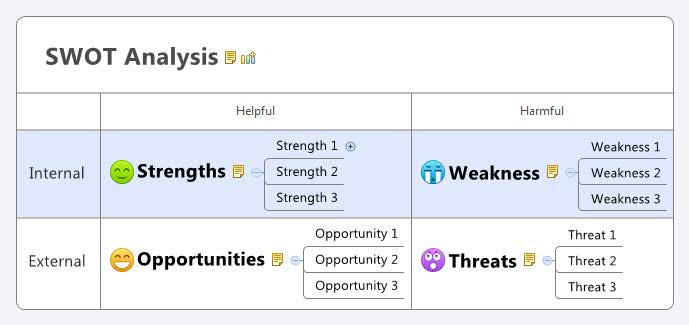This is the first in a series of posts on Business Analysis addressing different types of analyses that can help identify change within your organization which will help it grow and become more competitive. In this first post we’ll tackle SWOT Analysis.
SWOT analysis is a useful tool for understanding your business. It can help with strategic planning by uncovering opportunities or identifying a new direction to focus on. In can used as a framework for reviewing strategy, position, direction or even help flesh out any ideas you may have. It can help with decision making in different situations for your business or organization. It’s a great tool to use in a brainstorming environment to get the group to better understand the team and provide direction.
Although used mostly in a business environment, it can also be used at an individual level to help in building or identifying a career path by identifying your talents and opportunities and how best to utilize them.
Using SWOT Analysis
The basis of SWOT analysis is to identify the Strengths (S), Weaknesses (W), Opportunities (O), and Threats (T) – hence the acronym “SWOT” – of your business or organization.
SWOT analysis is normally addressed in a 4-quadrant table with each of the themes in a separate quadrant. Strengths and Weaknesses are looked at with an internal view; Opportunities and Threats are viewed generally as external factors. So Strengths and Weaknesses will appear in the first row labeled as “Internal”. Opportunities and Threats will be in the next row labeled “External”.
Also the themes can also be viewed as Helpful (Positive impact) or Harmful (Negative impact). So Strengths and Opportunities will normally appear in the first column labeled “Helpful” with Weaknesses and Threats in the second column labeled “Harmful”.
See image below as an example of a SWOT Analysis template:
Any appropriate tool can be used for the analysis – whiteboard, flipcharts, PowerPoint, Excel, etc. I prefer to use a mind mapping tool. I just find it them more conducive to brainstorming, whether with a team or individually. I currently use XMind – which is free.
Some general tips on conducting a SWOT analysis:
- Try to look at each of the areas from an external perspective, even when assessing internal factors. For example, what are your customers saying about each area of the analysis?
- Use only precise or verifiable statements vs. making general statements. To make the process simpler, you may initially hold off on quantifying your statements and come back to them after the initial analysis.
- If you end up with too many factors you will need to prioritize them. Don’t be shy here – prioritize relentlessly and identify the most important items.
Here are some questions/considerations for each of the areas:
Strengths – Characteristics that would help achieve a successful outcome or goals
- What are the advantages you have?
- What do you do better than others?
- What is your Unique Selling Proposition (USP)?
Weaknesses – Characteristics that might prevent successful outcomes or goals
- What could you improve?
- What should you avoid?
- Absences of strengths
- Factors contributing to past failures
Opportunities – Environmental factors that might influence/contribute to successful outcome
- What are some opportunities you see based on the current business climate?
- Do you see any opportunities based on the early analysis – Strengths and Weaknesses?
- Unfulfilled niches not being served – an unmet customer need
- Available prospects due to unique strengths or the elimination of a weaknesses
Threats – Environmental factors that might prevent a successful outcome
- What are the obstacles you see?
- What are your competitors doing to take business away?
- Upcoming changes to regulatory, political, social climates, etc.
After completing your analysis take a look at what you identified and determine how you can begin to act on them and make them real. If your list is too long, remember to prioritize the most important items then strategize a plan to make them happen.
This is not a comprehensive article on preforming performing a SWOT analysis, but these steps should get you going in the right direction.
If you need help with performing a SWOT analysis or the next steps, please contact us for assistance.
Please leave any comments or questions.

0 Comments
Leave A Comment